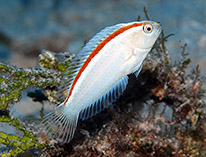| Family: |
Labridae (Wrasses), subfamily: Xyrichtyinae |
| Max. size: |
12.02 cm SL (male/unsexed) |
| Environment: |
reef-associated; marine; depth range 15 - 100 m |
| Distribution: |
Pacific: Papua New Guinea, Guam, Wake Island, and Tahiti. |
| Diagnosis: |
Dorsal spines (total): 9-9; Dorsal soft rays (total): 12-12; Anal spines: 3-3; Anal soft rays: 12-12; Vertebrae: 25-25. This species is characterized by the following: D IX,12, the first two dorsal spines flexible and shorter than longest dorsal soft rays; body depth 3.1-3.35 in SL; cheek scaleless; 2 small scales dorsally on opercle; gill rakers 17-20; juveniles and females whitish with a red stripe from above eye to back at base of dorsal fin; males with a pale-edged black spot on seventh lateral-line scale and scales below (Ref. 75958). |
| Biology: |
Found solitary or in small groups near reefs in sand-rubble bottoms (Ref. 90102). Feeds on small benthic invertebrates (Ref. 89972). Maximum depth reported taken from Ref. 128797. |
| IUCN Red List Status: |
Least Concern (LC); Date assessed: 03 March 2009 Ref. (130435)
|
| Threat to humans: |
harmless |
Source and more info: www.fishbase.org. For personal, classroom, and other internal use only. Not for publication.

